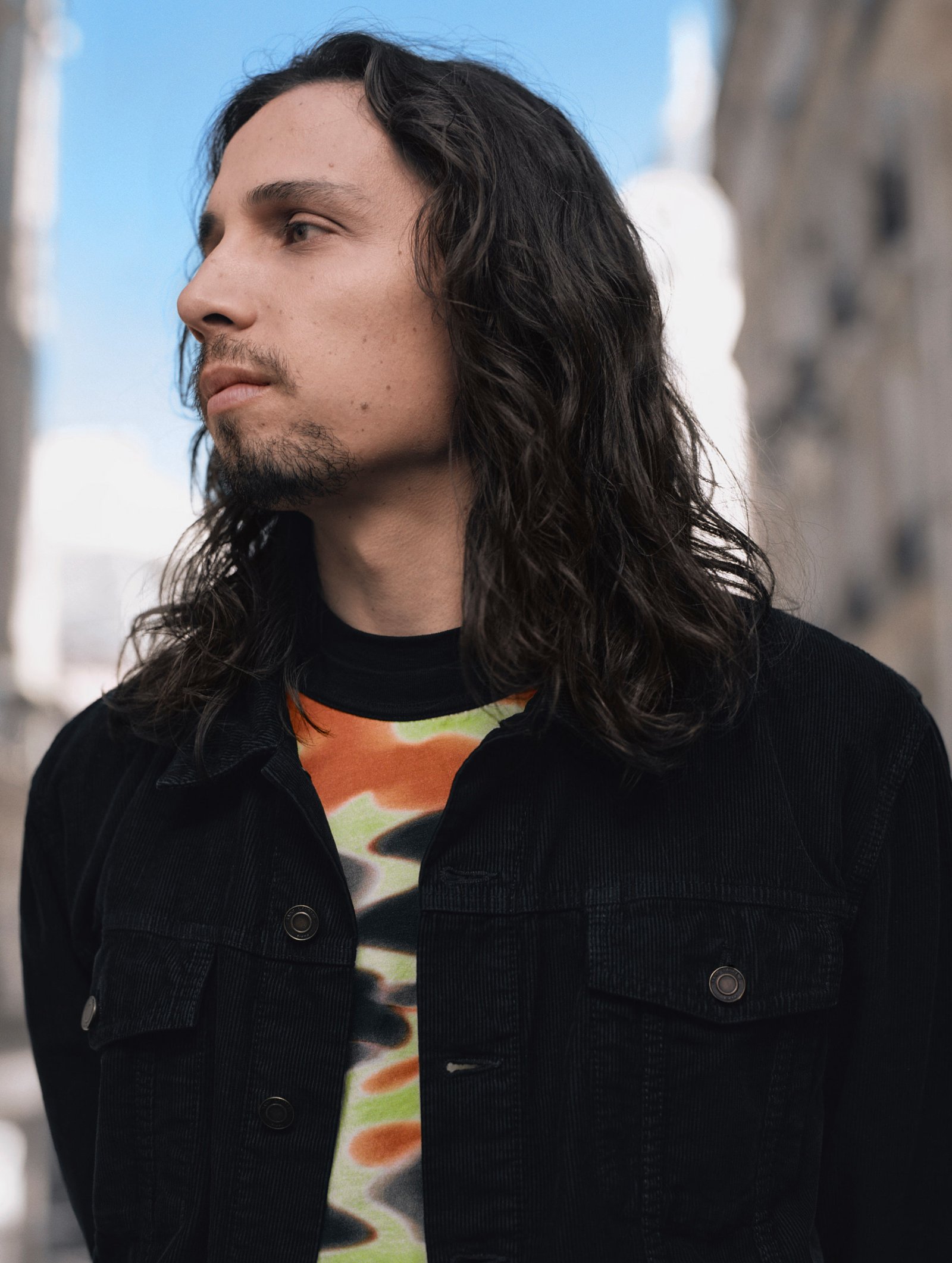Sable Elyse Smith’s America
The writer and visual artist pulls back the curtain on her multidisciplinary explorations of intimacy, education and incarceration.
Photography by Theo Choi
Text Qingyuan Deng
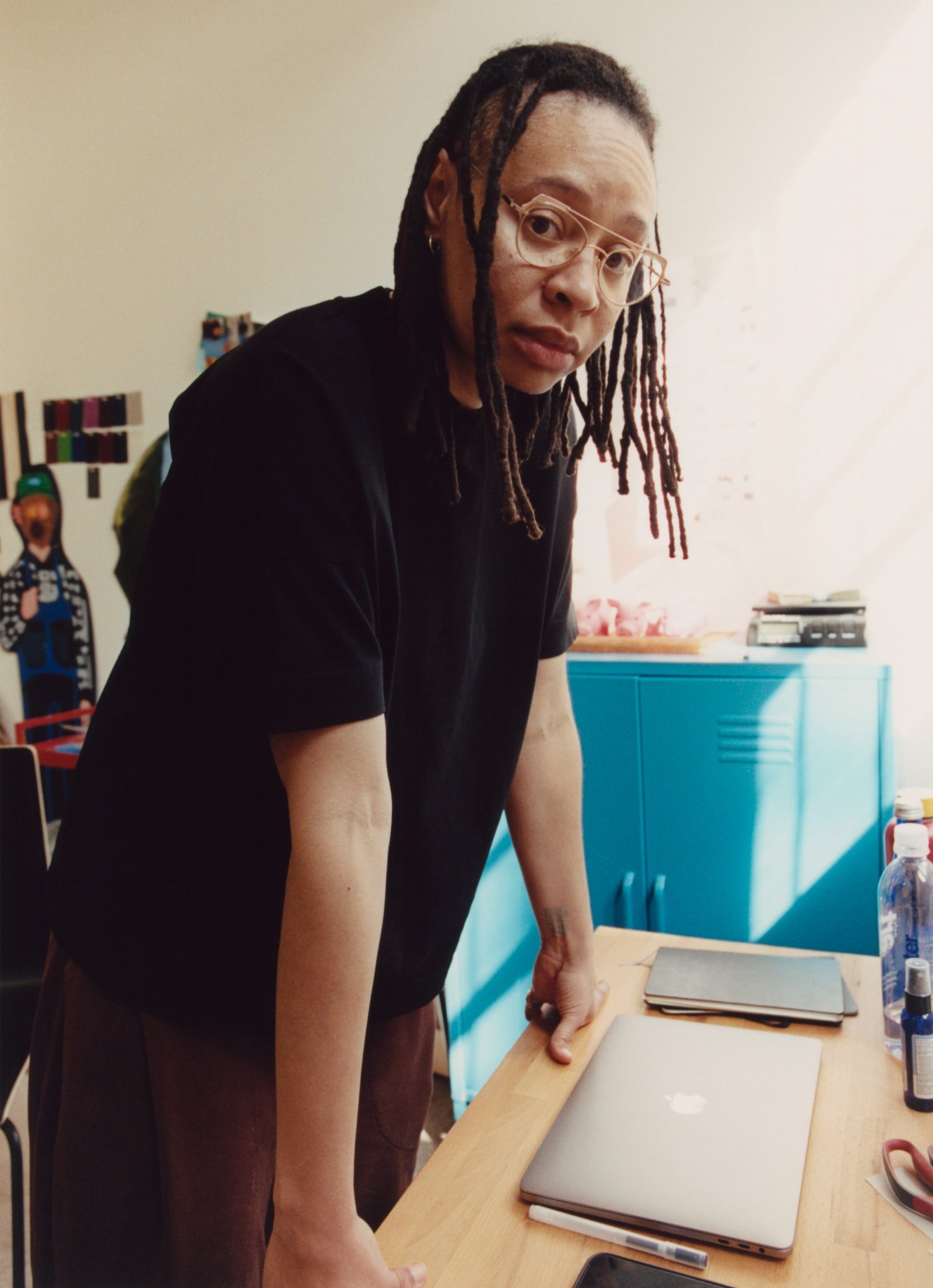
I first saw Sable Elyse Smith’s works in 2021. That year, the Los Angeles-born, New York-based artist was part of two major thematic group shows, which both grappled with the racialized logics of violence that have sustained America as a place and as an idea since time immemorial. For Marking Time: Art in the Age of Mass Incarceration at MoMA PS1, Smith exhibited a neon, text-based sculpture called Landscape V (2020), which spelled out the connection between sound and liberation: “Someone smashed the policeman’s radio / And finally silence / A black language infinitely / And blue in a decade when it finally means sky.” Throughout the years, those glaring wall-poems have continued to move and agitate me, concerned as they are with episodic memory, aspirations for freedom, and the ways we flow together—or, in many cases, how we are physically kept apart.
The blue of that poem, the color of Black folk music and the melancholia of subjugation, was reprised for the clinical infrastructure of Pivot II (2019), from the same exhibition. Pivot II is a powder-coated aluminum sculpture that muddies distinctions between a prison and a playground, often assumed to be opposite ends of the space-time continuum. Essentially a cube from which six steel rods affixed with blue disks project outward in the shape of an asterisk, the work takes formal cues from the seating in prison waiting rooms, which the artist frequented in her youth while visiting her father, who was incarcerated when she was ten. From these many sessions, Smith became familiar with how carceral infrastructures frustrate intimacy, from low-height furniture that obstructs the exchange of goods to those insultingly artificial landscapes of the Caribbean that serve as backdrops for family photos. These troubled memories formed the basis of her early work, after she moved to New York and began employment as a museum educator.
Part of what draws me to Smith’s work is her ability to get close to such difficult stories without forming any pornographic investment in their narratives. She’s adept at transmuting her rigorous observations into works that can be almost playful, even when concerned with tragedy or structural violence. In 2022, Smith displayed a sculpture called A Clockwork (2021) at the Whitney Biennial—a large-scale black Ferris wheel that trades passenger cars for replicas of tables and stools from those same visitation rooms, and whose unhurried rotation, unlike some fast wheel of fortune, points to no reward. Later, I would see her solo exhibition Tithe at JTT, where the artist appropriated pages from children’s coloring books, found on the streets of Harlem, that offer teachings about the judicial system.
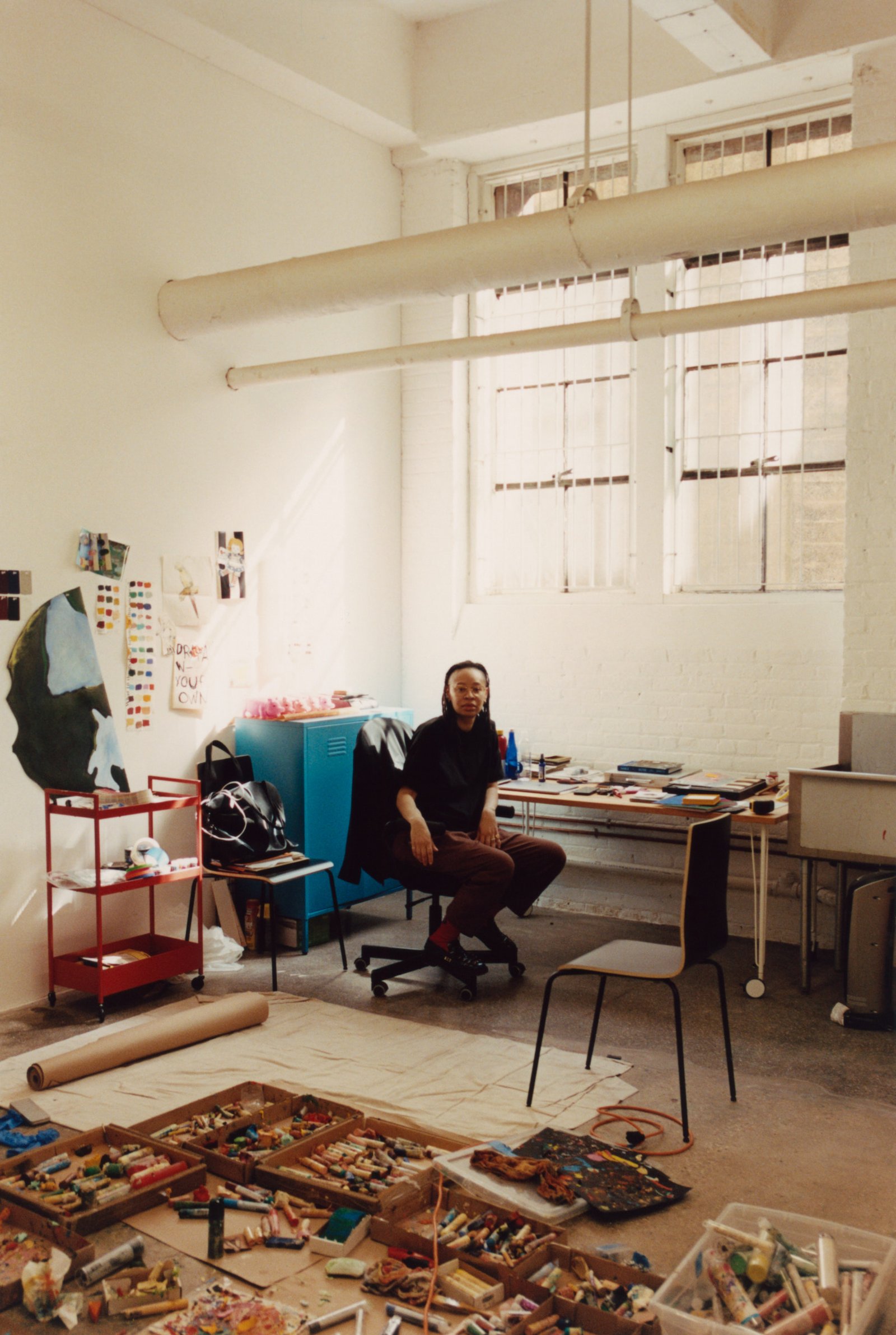
Smith at her desk.
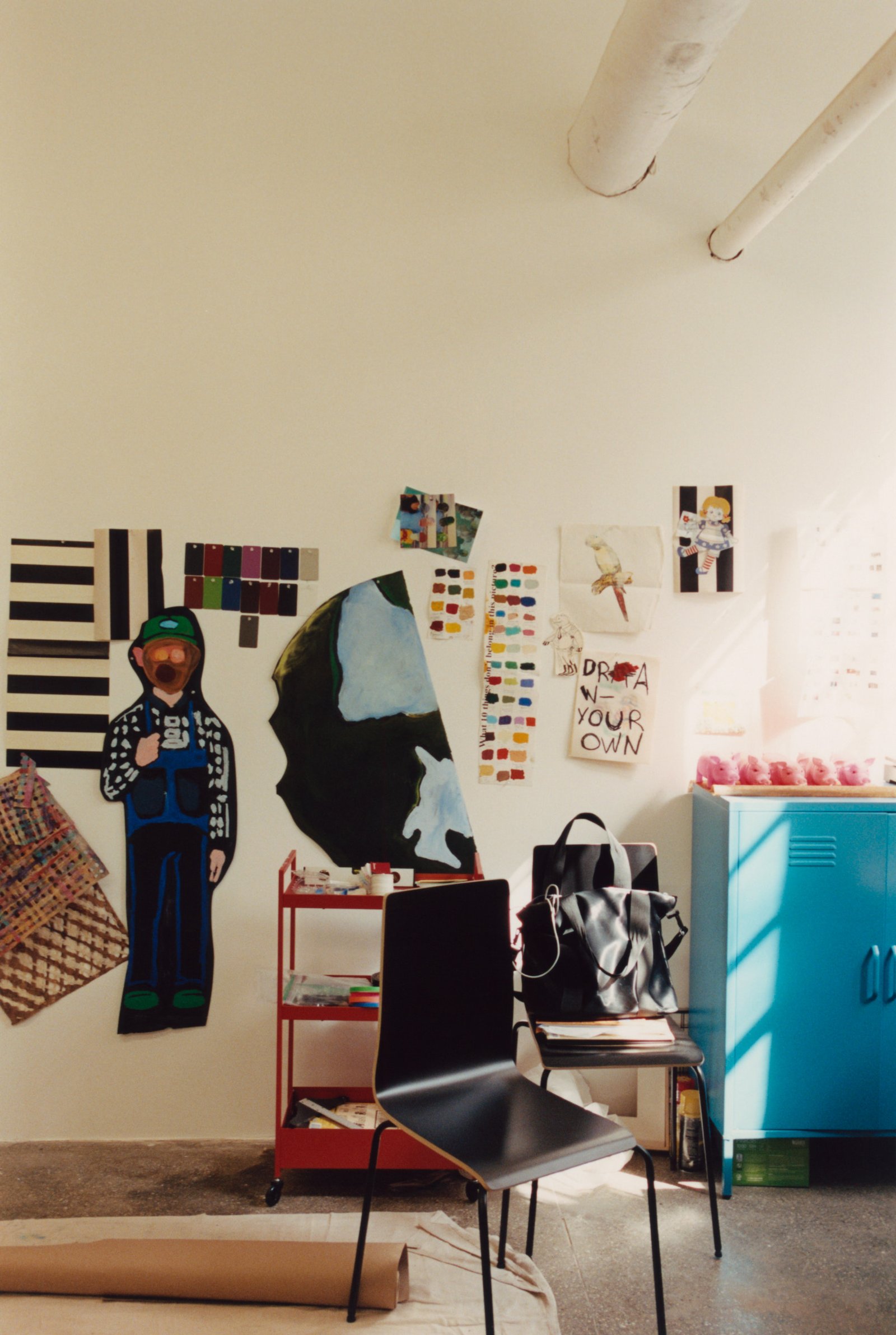
The artist’s walls reflect her creative process.
Last summer, I attended Smith’s opera at MoMA—a departure from her usual mediums. If you unfolded us, like past video work by Smith, is interested in opacity, unrepresentability, and making kin through refusal and retreat. A Black queer love story that celebrates the volatile twists and turns of desire, it opens with the two female protagonists interacting at a bar, working out the complexities of their romantic relationship. We’re given little information about their lives, though, and the bar feels less like a real place than a manifestation of their inner worlds. In this way, Smith avoids the clichés of nightlife as a refuge. Now developing the opera for future iterations and working on an upcoming solo show at the Contemporary Austin, Smith discusses the poetic sensibility that unites her diverse bodies of work.
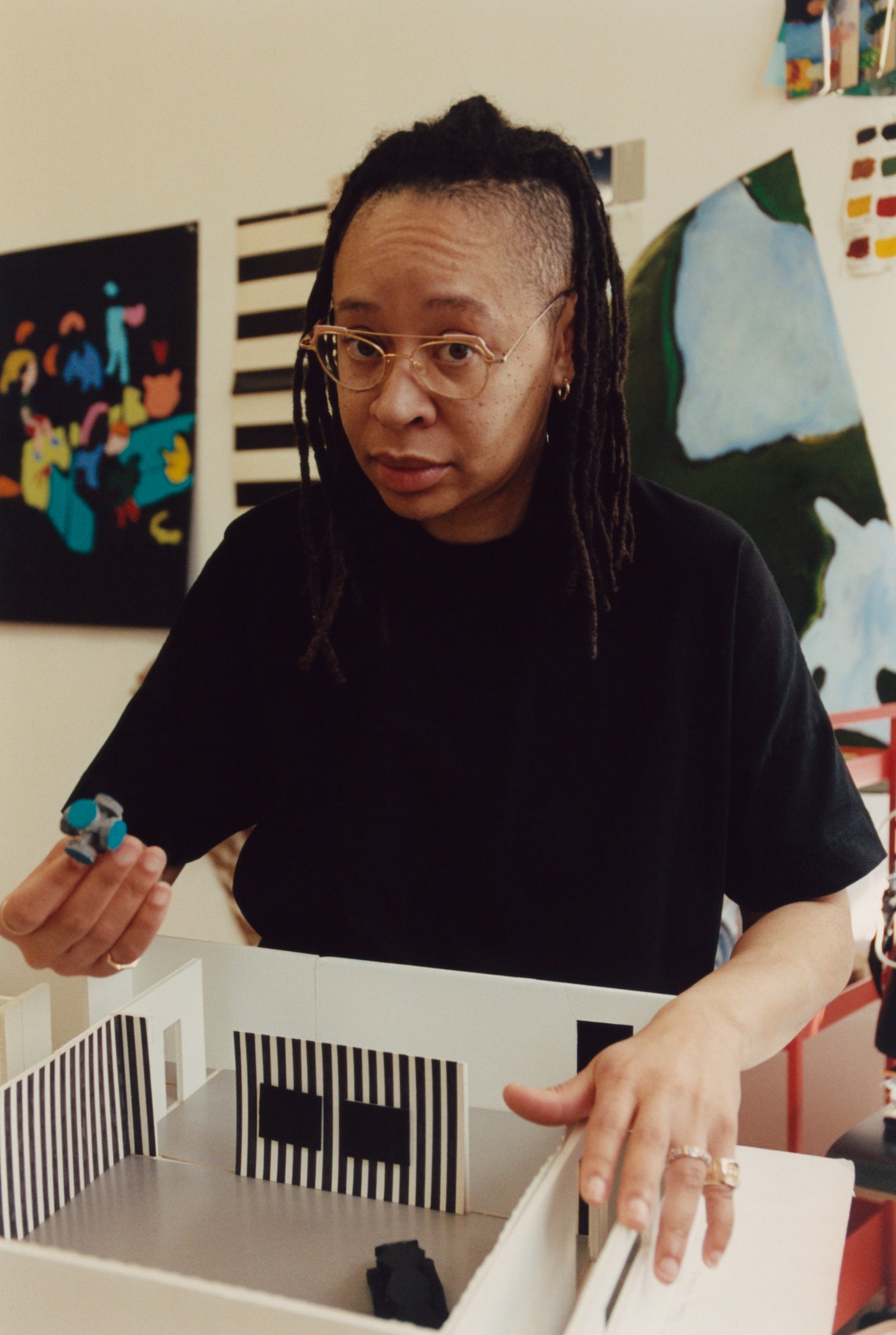
“Affect is constructed to some extent. So how does one create gaps, blips, or ellipses for the viewer to make a choice, or to decipher, or to fill in themselves?”
QD: I was browsing your website, and was struck by the first thing I saw: “Language is an architecture.”
SES: Language is probably the most consistent lens that I use to think about how to put something in the world. Fiction and nonfiction narratives are interesting containers that provide different possibilities for how to look at something. Language structures how we process the world and create definitions, institutions, laws, and social norms. When those things shift, part of it is because we are naming and labeling things differently. Obviously it’s more complicated [than that], but this naming has a lot of power. An optimistic outlook would be that language is free and expansive, but then there also is the reality that violence begins in naming.
QD: I saw your opera If you unfolded us at MoMA last year. At the time, I was reading a lot about how, in traditional Western philosophy, theater is considered an oppressive art form because it renders the spectator a passive receiver. What I loved about your opera is that it was open-ended, loose yet grounded, and iterative yet specific. How do you ensure the audience leaves your performances with the belief that they have been transformed?
SES: I don’t know if that’s the goal or can be controlled at all. I’m curious about the audience’s positionality in performance in general. What does one take away from it, and when? Personally, I’m intrigued by using a multi-sensorial framework to potentially provide a different type of immediacy for the audience to be affected, whether they intellectualize what the impact is or not. Duration is an interesting material. I am constantly trying to understand the ways sound, music, light, moving image, narrative, non-narrative, and actual images might work together. That curiosity is also carried into my more straightforward video work. Affect is constructed to some extent. So how does one create gaps, blips, or ellipses for the viewer to make a choice, or to decipher, or to fill in themselves? With the opera, there was also a program that accompanied it, which contained references, quotes, fragments of writing, and bits of the libretto. It was a place for some language to sit outside of the liveness of the performance, a place to point outward. So, in a small way, this points back to your question of the audience. An artwork can be anything—a constellation, a network—so why shouldn’t you be able to take something with you? I’m not sure what’s the “right” word choice here, but I like thinking about expanded aspects of a work that can recur and shift, and the various moments of encounter over time. You went to a performance, but that doesn’t mean the ideas around a performance are done.
QD: I remembered the opera set being very minimal, which left space for echoing. While physically there was reverberation, intellectually, sound can never be captured by language.
SES: Yes, sound is very exciting to me. It points to larger apparatuses and turns up the volume of complexity held in a space or an art object. I guess, when I have the opportunity, I like to think about the whole environment that things are placed in and all the possibilities of collision.
QD: In your recent work, I’ve noticed a shift from the idea of how the carceral state normalizes violence to investigations of childhood, and how the family functions. You are part of the group show On Education at Amant, showing your Coloring Book series. What do you think about the renewed interest in, or reorientation towards, pedagogy, family, and childhood in your practice?
SES: You made an astute observation. I think it has more to do with external curatorial interest and observation. The analysis of childhood has always been present in the work, and yet prison is the most legible subject for people to pull out. We’ve also moved through a very particular moment where the art world was focused on and oriented around exhibition-making in the prison context. And some of those exhibitions are incredibly important, like Nicole Fleetwood’s Marking Time—but that’s in a category of its own. It didn’t come out of the art world; it is a body of scholarship that collided with the museum context. It’s propulsive!
What I’m finding more recently, and hopefully finding more of, is conversations around the formal elements of the work and the intersections of the various contexts that populate the work—of which carcerality is definitely one. Just more attention to all the material, formal, and conceptual layers of the work is taking precedence over the more obvious. I think there is a deeper analysis of the practice that’s happening, coinciding with a cultural shift in the moment that is focused on childhood. And here we are. The work hasn’t changed.
QD: Michel Foucault told us that schooling and education are related to how the modern state manages its subjects. School is like a prison; childhood had been neglected in intellectual history until the 20th century and the birth of psychoanalysis. But visibility can also mean disempowerment and subjugation. How do these contradictions relate to the works you are showing at Amant?
SES: I have two pieces in that show. They’re from this series of paintings based on coloring books for children. I am attracted to the simplicity of narratives and activities in these books. Early childhood development fascinates me, because it is a question of control related to imagination. The management or control of subjects is most pronounced when you look at what’s permissible in their institutions or agents of learning and information. Free thinking does not perpetuate one’s controllability. Institutions fear a subject’s ability to imagine, and to imagine anything beyond the social-national narrative they are being given to consume. For the two paintings, I put pigment and marks on pages from coloring books, but the project is conceptual. The marks are a byproduct. What’s important is the text, how you situate that text in the context of the image, and what it means broadly about the purposes of education or the use value of said object. The logic of reorientation also fascinates me. The mark allows a rereading. Is it the unruliness of the mark, the mark out of place, the mark out of bounds, or the subject “colored” differently [that is] defiant of an expectation set? There are infinite questions. We take a lot of things for granted in the United States, and maybe now we will start to see how false our comfortability and entitlement to freedoms are.
QD: You mentioned fear, which is important to your work. It reminds me of the insistence that society must protect children at all costs, and that childhood is innocent. Yet innocence is such a diluted word to describe the experience of growing up. It’s an illusion that children never learn about the violence of everyday life. I really like your confrontational approach toward thinking about how pedagogy might have failed us.
SES: I guess locating things assumed to be neutral and recontextualizing them is the process, is the work. A coloring book appears to be non-threatening. But simply asking why it exists can reveal so much about our education models, which privilege certain types of behavior, thought, and information. I have been making these sculptures that are also about “the generic,” in a way. They are simplistic geometric forms that create all-in-one table and chair units that exist inside of the prison space. So in the most basic sense, everything has a history. Everything comes from somewhere. I am committed to italicizing these histories—making sure the emphasis is in the right place.
QD: I think there is also the idea of serial production, which relates mass production and the prison, both systems of standardization.
SES: Yes, seriality is the content of the sculptures. Of course, there is a complex economic structure around prison. Seriality is an important framework for illustrating the scale of the production and the scale of the profit that’s produced. The profit is only produced if people populate the space, by any means. So then laws are produced, as one small example. The question of scale also feels like a rhyme. There’s the scale of the actual sculptures and the scale of them in space and all the different contexts that they represent: scale of impact, from both a micro and macro perspective, scale of the enmeshment with the GDP. That’s why seriality is so important to me.
QD: I know you are an educator, too. Education has traditionally been framed as a one-way street. Progressive pedagogy attempts to give students the agency to shape their teacher and to relearn about themselves. I’m wondering if you have thought about how students are empowered by your practice.
SES: I don’t know that I would say students are empowered by my practice. I’ve worked in various educational capacities for the last 15 years. The thing that feels the most important to me is to encourage, teach, and analyze, but I think it’s my job to help students locate individual agency within educational systems, help them uncover where that is possible. This kind of exchange could happen at various scales. I ultimately want to be an advocate within the different environments I exist in, even on the smallest levels. There is the curriculum we teach and then there is the informal learning and the inadvertent ideas that get dismantled or reified in these formal education spaces.
QD: In terms of scale: Your videos and writings are the most expansive forms of presenting ideas, because writing can be easily circulated and is open to interpretation, while video is literally worldbuilding. Your sculptures are in the middle: physically imposing, but confined to certain spaces. And education is the most localized, the most micro-dynamic. Do you think about scale as a model?
SES: Yes, I think about scale a lot in my work, because ideas and their impact exist at a scale. Obviously, some things are local and immediate, and others are almost unquantifiable. Locating information within the contexts and scales it operates within can produce a new understanding of the world. A common refrain is, “I don’t have a direct experience or relationship to incarceration,” and maybe I’d argue to whoever was speaking that they are probably looking at the wrong scale.
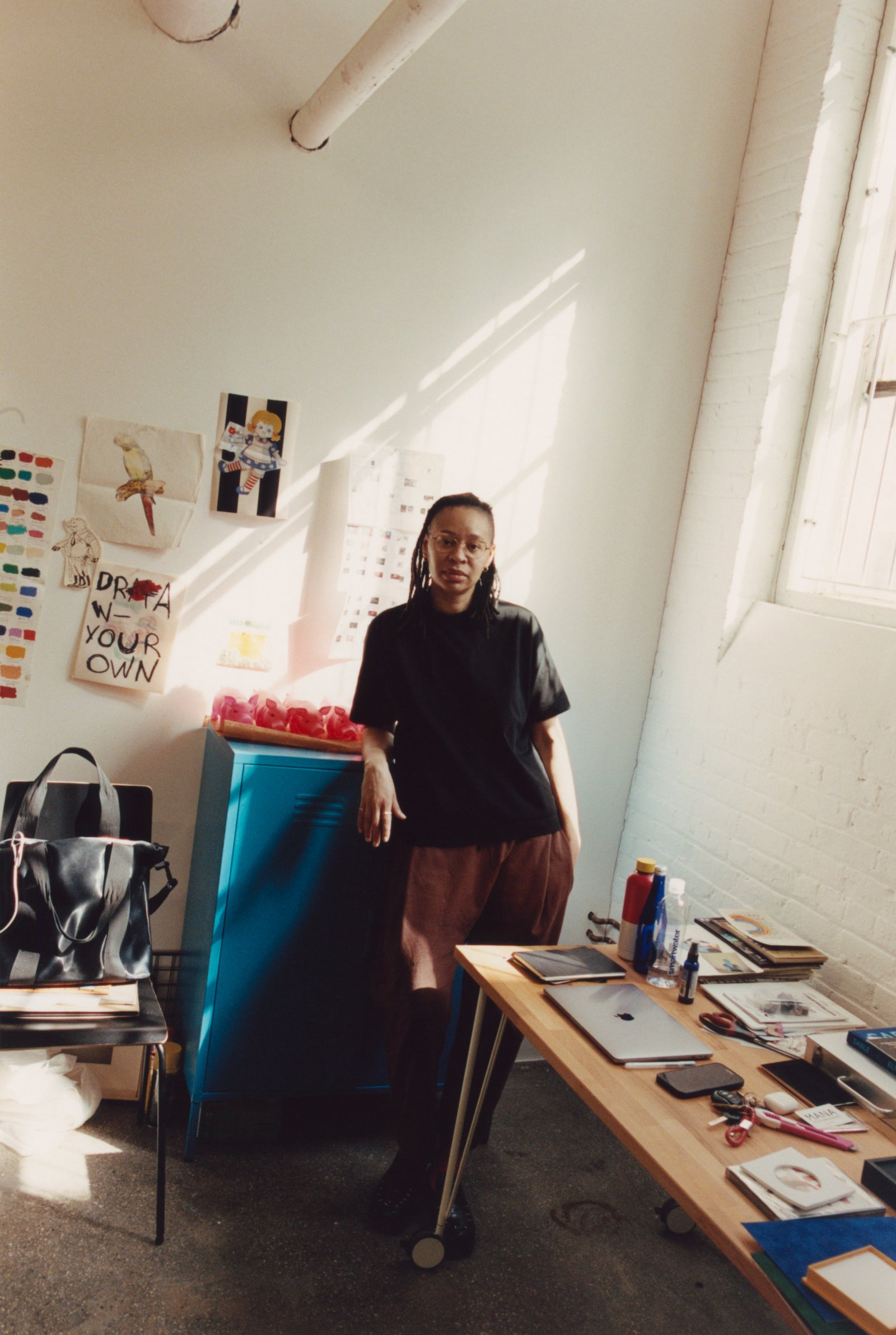
QD: What are you working on in your studio right now?
SES: I’m working towards two solo shows in 2026. Primarily this show at the Contemporary Austin, which will open in the spring of next year. It’s going to be a mix of old and new work. And a version of that show will travel to the FLAG Art Foundation. It also will be a nice exercise, because FLAG’s space is a lot smaller. I am curious how the narrative shifts, what that smaller show might reveal itself to be about.
QD: Are you reading anything interesting right now?
SES: I read a lot of poetry, and that dominates a lot of my thinking about images, juxtaposition of images, how to sequence images, and time. There’s the time of video, filmic time, poetic time, and popular musical time—I could go on and on. Duration and time are big characters in my world. The refrain is something that’s interesting to me across mediums. I’ve been listening to this symposium on photography that MoMA did back in October, over and over again. The symposium is about photos specifically, but I like extending it to images beyond the format and in relation to that history. I’m an image-maker. Sculptures can also be images at times. Recently, I’ve been reading Leila Taylor’s Sick Houses: Haunted Homes and the Architecture of Dread. I read a lot of Simone White, Amiri Baraka, Ocean Vuong, Douglas Kearney, Tyehimba Jess, and Saeed Jones. Especially with poetry, I read a lot at once, so this is not exhaustive—just the books I’ve pulled out this week. I’ll put them back, then rotate in some more. I’ve been reading quite a few plays and Edward Said’s text on opera.
QD: What are you watching these days?
SES: I watch a lot of films and other forms of moving images too, which obviously have become even more ubiquitous these days, with the way we engage the internet. I’m not particularly interested in online culture, but I’ve paid attention a little, as we think about how time starts to function differently. I guess I just rewatched I May Destroy You, specifically because I wanted to go back to the narrative structure. I also just watched Typhoon Club by Shinji Sōmai for the first time and one of my group chats is blowing up with the influx of dystopian end-times content—so Silo and Paradise are in that vein.
QD: I think film requires slowness, and slowness is important to your work.
SES: Definitely. Rhythm is important too, especially in thinking about the edit of my videos. For me, the way that I make films or videos is all about the edit, which feels more akin to a writing practice—as opposed to, like, if I was sitting down to think about my approach to making a feature narrative film. Who knows?
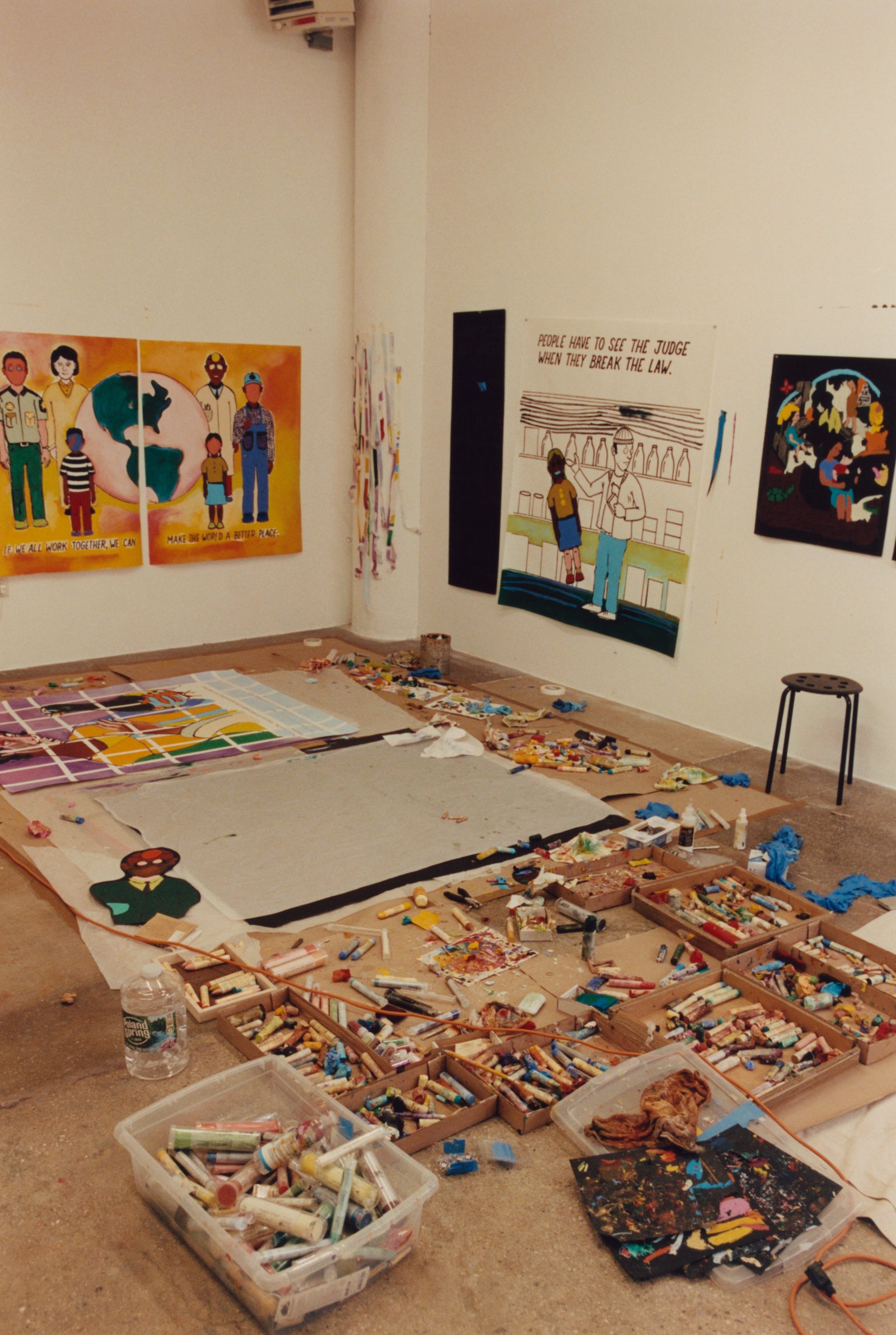
For larger works, Smith takes advantage of floor space, making sense from clutter.
